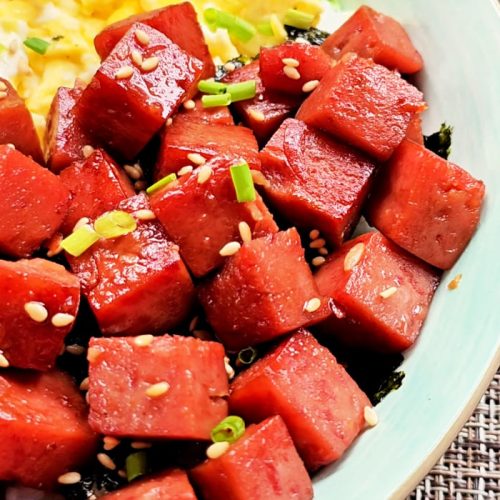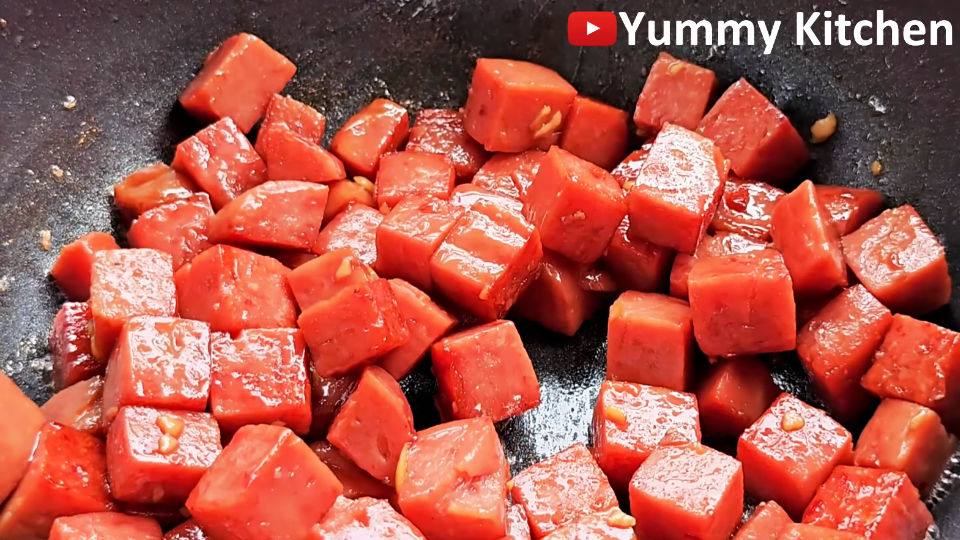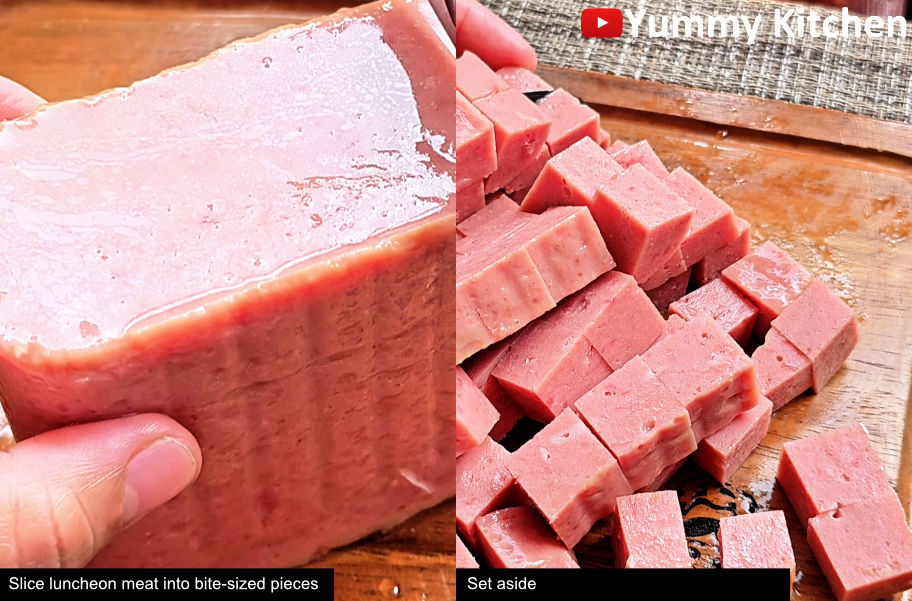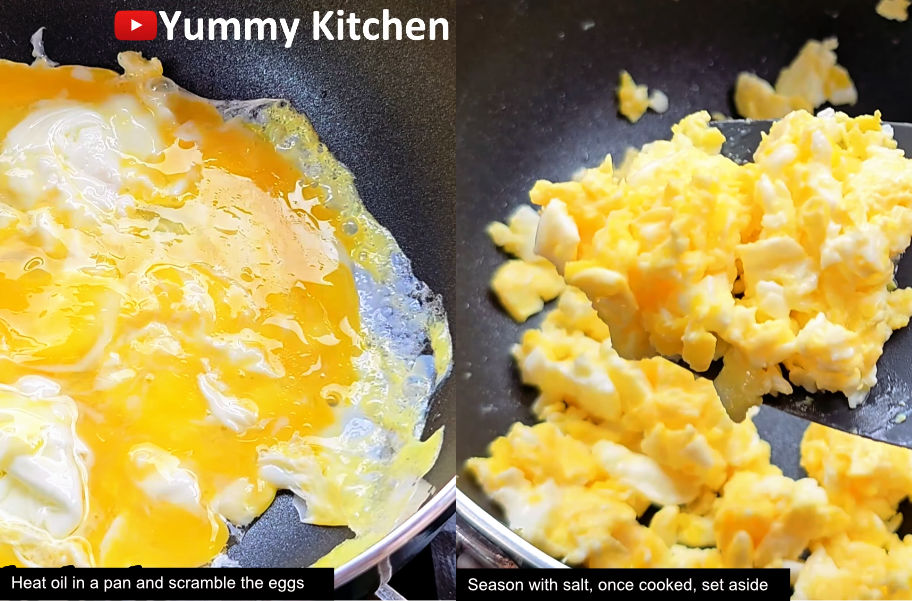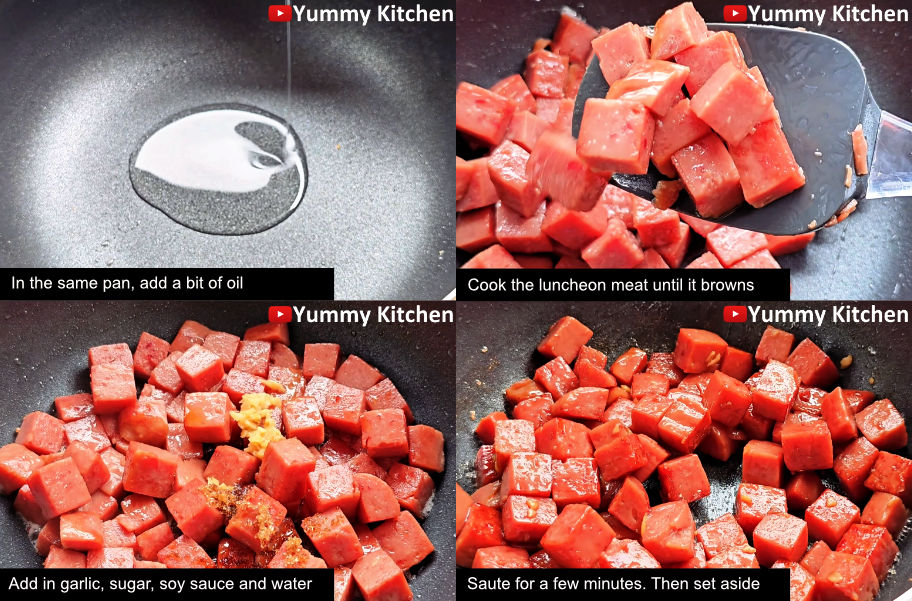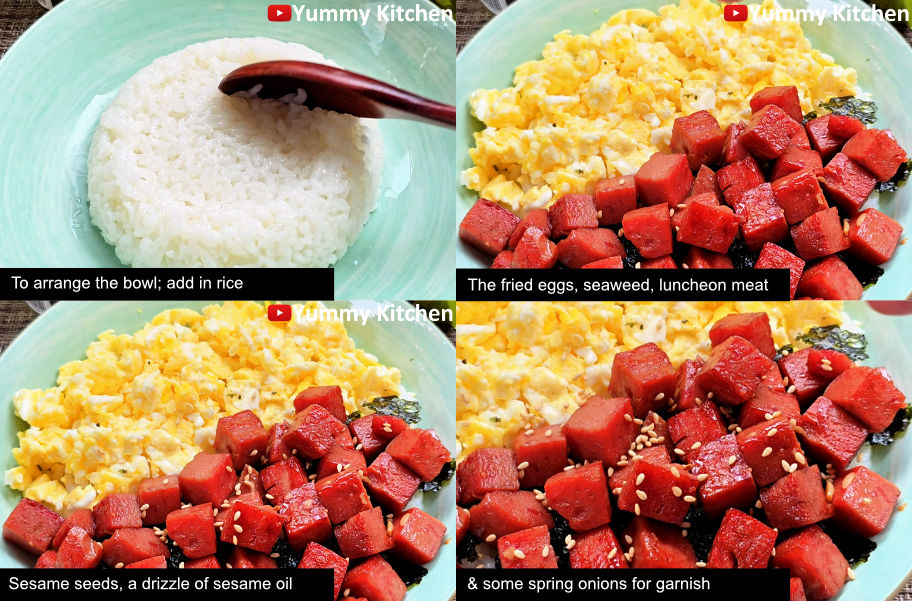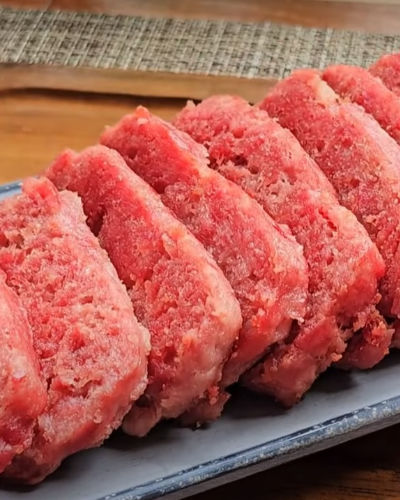Musubi Bowls
Spam Musubi Bowls also called “spam and rice bowl” or “spam musubi rice bowl” is a delicious Hawaiian dish that combines sweet and savory flavors in each irresistible bite. Spam glazed with a simple teriyaki sauce, place under freshly cooked rice, with a side of nori and eggs. It’s easy to make, very filling, and great anytime of the day.
Spam Sushi Recipe
Ingredients
- Spam or any luncheon meat
- 2 medium eggs
- 2 cloves garlic minced
- 1 tablespoon sugar
- 1 tablespoon soy sauce
- 1 tablespoon water
- 1 cup rice
- Seaweed torn to bits
- Sesame seeds
- Sesame oil
- Spring onions optional
Instructions
- Slice the Spam or luncheon meat into bite-sized pieces. Set aside.
- Heat oil in a pan and scramble the eggs. Season with salt, once cooked, set aside.
- In the same pan, add a bit of oil and cook the luncheon meat until it browns. Add in garlic, sugar, soy sauce and water. Saute for a few minutes. Then set aside.
- To arrange the bowl; add in rice, the fried eggs, seaweed, luncheon meat, sesame seeds, a drizzle of sesame oil, and some spring onions for garnish.
Video
For those craving a simple savory Hawaiian-inspired meal. This Spam Musubi Bowl is a must-try! A flavorful dish that takes all the classic elements of a traditional musubi-seasoned rice, a touch of seaweed, scrambled or fried eggs, and pan-seared Spam or any type of luncheon meat that’s been flavored slightly with teriyaki sauce. This full meal combines salty sweet flavors that make this comfort food a beloved favorite.
Spam Musubi History
This Spam dish has been a popular Hawaiian snack since World War II. Grilled Spam over rice, wrapped in nori was adapted by Japanese immigrants from the traditional “musibi” or “rice balls”. This iconic dish has become a cultural symbol of Hawaiian fission cuisine.
From being a popular ration eaten by American troops stationed in Hawaii and other Pacific areas. The creator of this has been debated. From Barbara Funamura, a Japanese American woman who had a restaurant on Kauai. To Japanese American internment camp survivors. Funamura reportedly used a rice press or “oshi” to turn this into a block of rice, topped in with a slice of Spam in the middle and shape this perfectly using a strip of nori/seaweed to tie this all together.
Now in modern day, the iconic musubi is still as popular as ever. There are even spam musubi makers sold to make solo musubis, to steel ones that make a lot at a time, or even homemade ones using the cans itself and some cling wrap. There are a lot a lot of variations from spam musubi bowl that seems like a deconstructed musubi, using different meats aside from Spam like other brands of luncheon meats, hot dogs, chicken, pork, and fried rice using the leftovers.
Spam Musubi Ingredients
- Spam – you can also use any luncheon meat, maling, or even hot dogs.
- Eggs – for color and protein.
- Garlic – adds aroma and enhances the flavor of the dish.
- Sugar – for sweetness, this also helps add a nice caramelization over the luncheon meat.
- Soy Sauce – for umaminess.
- Water – to help dilute the ‘sauce’ better.
- Rice – for the base of the bowl.
- Sesame seeds – for nuttiness and crunch.
- Sesame oil – to add a touch of nutty flavor/
- Seaweed and Spring onions – for garnish.
Spam Sushi Recipe ( How to make Musubi Bowls )
Ingredients :
- Spam ( or any luncheon meat )
- 2 medium eggs
- 2 cloves garlic ( minced )
- 1 tablespoon sugar
- 1 tablespoon soy sauce
- 1 tablespoon water
- 1 cup rice
- Seaweed ( torn to bits )
- Sesame seeds
- Sesame oil
- Spring onions ( optional )
Steps :
1. Slice the Spam or luncheon meat into bite-sized pieces. Set aside.
2. Heat oil in a pan and scramble the eggs. Season with salt, once cooked, set aside.
3. In the same pan, add a bit of oil and cook the luncheon meat until it browns. Add in garlic, sugar, soy sauce and water. Saute for a few minutes. Then set aside.
4. To arrange the bowl; add in rice, the fried eggs, seaweed, luncheon meat, sesame seeds, a drizzle of sesame oil, and some spring onions for garnish.
Musubi Bowls Questions:
- Spam musubi calories
How many calories are in a spam musubi bowl? There are around 200 to 280 calories in each bowl depending on how much rice or spam is added.
- Spam musubi bowl ingredients
- Chicken Musubi – To make a spam musubi bowl with chicken, all you need is to replace the spam with chicken breasts pounded thinly, then panfried until golden. Set aside while you make the 5 times the amount of the sauce in the recipe, with the addition of a slurry ( 2 teaspoon cornstarch and 2 tablespoons water), simmer until thick before adding back the seared chicken. Once the chicken is slathered with the sauce, this is ready to be used as a spam replacement.
- Shoyu Tuna Musubi Recipe – one of the more affordable options in this different musubi recipes list. Use canned tuna, strain these for a few minutes before following the steps, as written on the recipe. Using this instead of the luncheon meat, saute these only until slightly browned before adding in the sauce.
- How to make a spam musubi sauce recipe ?
The best sauce for spam musubi is the simple teriyaki sauce. The blend of savory, salty, umami, sweet, and garlicky. It’s simple, foolproof, easy to recreate and can be easily dressed up or dressed down depending on one’s tastes.
- Other ways to recreate this dish ?
This easy spam musubi recipe without mold is already easy enough. But if you also want to enjoy this delicious preserved meat in different ways here are some examples:
- Try this “Fried Spam Musubi Recipe” – make the musubi, freeze these, before dipping in a batter made of 1 egg, ½ cup flour, ½ cup cornstarch, 1 teaspoon baking powder, 1 tablespoon salt, pepper, and garlic powder, and any seasonings you like, adding cold water a bit at a time ( 1 tablespoon at a time ) until you have a thick but easy to dip in batter. Freeze, dip, and fry and repeat to make this dish.
- “Spam Musubi Bake” or “Spam Musubi in a Pan” – in this version all you need to do is change the way the recipe is served. Instead of a bowl, use a pan and follow the steps as is. Or you can place in the rice, top with the semi cooked eggs ( try to cook these only halfway / still slightly wet ), and spam bits that have been tossed in the sauce. Bake at a 150°C or 300°F preheated oven for 10 – 15 minutes or until the spam looks slightly charred.
- Other sides
You can definitely serve Spam Musubi without seaweed, or eggs. It really depends on what you prefer. You can replace the seaweed with pickled radishes, kimchi, hijiki salad ( Japanese seaweed salad), or more. You can also change the rice with your favorite type like Jasmine rice to make “Spam Musubi with Jasmine rice”, use sinandomeng, or whenever is within your budget or preference.
- How to reheat Spam Musubi Bowls ?
You can place the leftovers in a microwavable bowl or container and heat it up for 30 seconds to 1 minute, or until it’s hot enough. You can also pan dry these over medium-low heat. Sauteing it into a quick fried rice until warmed.
Experience the sweet, savory, umami flavors of the islands with this Hawaiian Spam rice bowl. A delicious even more filling twist of a classic favorite. It’s basically Spam musubi in a bowl. This combination of juicy Spam, freshly cooked rice, fluffy eggs, nori, and a drizzle of sesame oil for an easy-to-eat format.
Try our other Recipes using Luncheon Meat :
Spam Rice Bowl Recipe ( Tagalog )
How to make Musubi Bowls
Mga Sangkap :
- Spam ( o kahit anong luncheon meat )
- 2 itlog
- 2 butil ng bawang ( tinadtad )
- 1 kutsara ng asukal
- 1 kutsara ng soy sauce
- 1 kutsara ng tubig
- 1 tasa ng kanin
- Seaweed ( hinimay )
- Sesame seeds
- Sesame oil
- Dahon ng sibuyas ( opsyonal )
Paano Lutuin :
- Hiwain ang Spam o luncheon meat ng maliliit na piraso. Itabi.
- Maginit ng mantika sa kawali at iscramble ang mga itlog. Haluan ng konting asin. Pagluto na, itabi.
- Sa parehong kawali, maginit ng konting mantika at lutuin ang mga luncheon meat hanggang mag kayumanggi. Haluan ng bawang, asukal, soy sauce, at tubig. Haluin ng ilang minuto bago itabi.
- Ihanda ang mangkok, Ilagay dito ang kanin, lutong itlog, seaweed, luncheon meat, sesame seeds, konting sesame oil, at dahon ng sibuyas.


